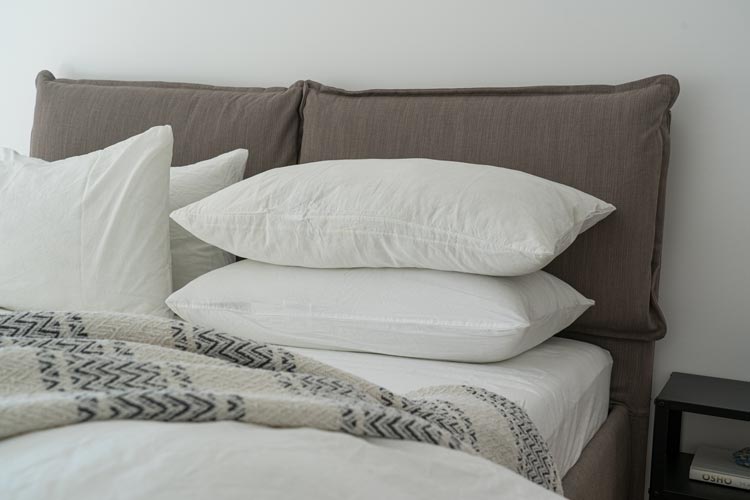
6 Signs It’s Time To Replace Your Mattress
Contents
Still unsure if it’s time to let go of that old and worn out latex mattress? You should never skimp on quality when it comes to investing in new mattresses.
In this article, we take a deep dive into the different types of mattresses, the signs that show you need to replace your mattress, and some useful tips to make your mattress last longer.
Different Types of Mattresses
There are many mattress types on the market today — each having their own distinct qualities, materials, designs, quirks, and perks.
Here, we focus on the most common types of mattresses to help you explore the different options and narrow down the type of mattress that is best for achieving that good night’s sleep.
Latex Mattress
Known to be among the most durable mattresses in the industry, the all-natural latex mattress uses latex foam as its support system and can be made from plant- or petroleum or synthetic-based materials.
This type comes with a host of benefits —from providing more comfort and firm support to being allergen-free, aiding in pain relief and perfect spine alignment, and higher bounce back capacity.
Memory Foam
This type of mattress contours to the specific shape of your body and has an advanced capacity for absorbing motion and pressure points and responding to weight and temperature.
Since it gradually conforms to the body as one sleeps, memory foam works well for people with certain types of muscle and body pain and those who find it hard to get comfortable while sleeping.
Innerspring
Innerspring mattresses are among the most widely used because they are available in a wide range of budget-friendly options. This type uses a steel coil support system and is covered by a wide variety of materials added for comfort — from pillow to latex to memory foam.
Innerspring is best for a back sleeper because it provides firm back support and spine alignment.
Hybrid
This type combines innerspring coil systems and layers of memory foam or latex. A hybrid mattress is a great option for those who like to sleep cool and for couples who have different firmness preferences. It also offers pressure point relief without compromising on back support.
Mattress Lifespan
Generally, it is recommended for people to replace their mattresses after using them for 7 to 10 years. Still, there are mattresses that can last beyond 10 years and more depending on the level of care.
What is important to note is that even the most durable and well-made mattresses can suffer significant wear and tear if proper care is not given them. Besides mattress style and quality, the other factors that affect mattress lifespan include: how you sleep on it, the frequency of use, body weight and activity, and cleaning.
On average, latex mattresses can last up to 15 years if properly maintained. Memory foam mattresses with higher density material come in second and have mid-length longevity of about 10 years.
One can expect a high-quality hybrid mattress to last around seven years. Innersprings, meanwhile, have metal springs that are prone to wear and tear and sagging. This type has an average lifespan of 5 to 6 years.
Warning Signs It’s Time to Replace Your Mattress
Here are some top signs that tell you it’s high time that you get a new mattress.
1. You notice that it’s lumpy and saggy
Are there too many dents or lumps? Lumps can happen over time, no matter what material your mattress is made of. These lumps and bumps under your sheets are the most obvious signs of wear and show your mattress can no longer provide the support you need when you sleep.
If you notice that you sink deeper than two inches into the foam, then it may be time to move on to a new and better mattress.
2. Your bed makes noises
Your bed shouldn’t make a lot of loud noises, even when you are tossing and turning. Squeaks and creaks and the sounds of grinding metal aren’t normal and can signal that the foundation of your mattress is no longer strong.
3. You wake up with body aches and pains
Do you have morning back pain or achy joints on a regular basis? A worn-out bed mattress may no longer support your spine’s natural curve, causing that pain. This is also a sign that the innerspring or foam cells are starting to break down.
4. You wake up feeling exhausted
If you sleep for seven to nine hours per night and still wake up feeling tired, then it’s highly likely that your old mattress is showing signs of wear. A mattress that is uncomfortable and unsupportive also gives you a hard time falling and staying asleep on it.
5. You notice a surge in allergy or asthma symptoms
Over time, your mattress can accumulate dust, mildew and other harmful contaminants that can trigger or intensify allergic reactions and negatively impact your overall health. Some compounds that are used to make mattresses, such as glues or polyurethane foam, can also cause skin issues.
6. You’re more comfortable sleeping elsewhere
Do you find yourself getting a better night’s sleep on a bed that is not your own, like on a hotel mattress or at your friend’s house? Then it’s time for a new mattress that can give you the restful sleep you need.
Why Should You Change Your Mattress
Investing in high-quality mattresses does more than just boost your comfort. It’s also about prioritizing your health. An uncomfortable and unsupportive mattress will cause you to lose hours of sleep. And when you don’t get a better sleep, you are more vulnerable to stress that can negatively impact your daily life — from your mood and productivity to your relationships.
Better sleep leads to a healthier and happier life. A new mattress that improves your quality of sleep will not only reduce body aches and back pain but will also decrease your risk for a number of diseases that include arthritis, diabetes, heart disease, and stroke.
Plus, putting in your extra money for a higher quality, better performing mattress now will allow you to save money in the long run. Research and get better mattresses that you know will stand the test of time.
Tips to Make Your Mattress Last Longer
Here’s how a little care and maintenance can go a long way to ensuring that your mattresses are in tip top shape and last longer.
Don’t Jump On Your Mattress
Don’t let you or any other person get too excited with your new mattress that you jump on it for hours. Jumping causes dents and deformations that can compromise the mattress core and decrease its lifespan.
Flip Your Mattress Frequently
Sleeping on one spot every day predisposes your mattress to wear and tear in that particular section. Flip your mattress once every few months to distribute pressure points and even out the dents and creases caused by your movements. Innerspring, hybrid, latex, and memory foam mattress generally require the occasional 180-degree rotation.
Ensure Your Mattress Is Properly Supported
A mattress that rests on a bad support often turns uneven over a period of time. Follow instructions and advice on choosing the correct line of support for your mattress. With a bigger bed, such as a queen and king, it is best to have bed frames that can support the weight of the mattress without breaking.
Firm and proper support will not only work best for durability but also helps prevent damages to your mattress.
Use Mattress Covers
Mattress covers are among the simplest ways to preserve your mattress and keep it protected from spills and stains. Some mattress covers are designed to not only guard against spills and accidents, but also to reduce the amount of dust mite, debris, and dirt that make it into your bed.









